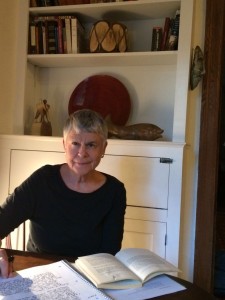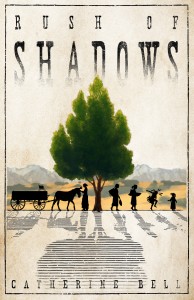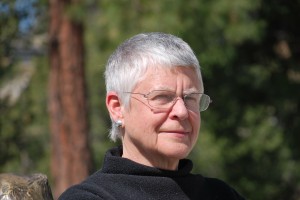Where it Happened

Catherine Bell
The place frustrated me, intrigued me, wouldn’t let me alone. It was a valley in the Coast Range of California a fair drive north of San Francisco, where we visited my husband’s family summer after summer. The land was beautiful, with rolling hills, steep ridges, and mountains blue on the horizon. Hawks skimmed the firs and cruised the bright, sunburned slopes.
It was ranch country, mostly cattle. The town had a creamery, a Rexall, a redwood train station, a procession of heavy logging trucks down Main Street, a restaurant that went bankrupt every other year, no classical music on the radio, and an oasis, a second-hand bookstore. To a New Englander, nothing seemed old enough. I tried to get out into the country, at least to walk, but everything was fenced.
When neighbors opened a trail across their land, I discovered the fragrant pepperwood shade, the peeling red madrone, the pebbled streams, the blackberry tangles. Now I was in love with the land, but something still was missing. There must have been people here.
Where were they? My husband recalled the germ of a story told by his grandmother. Born on a ranch in 1869, she used to play with Indian children. But when she was four, the Army came to round the Indians up and march them to the reservation.
 I felt the sadness and injustice in the separation of friends. Later I realized “round up” meant the Army was making a clean sweep, didn’t want Indians around, was prepared to treat them like animals. It took me longer to be properly curious, to find out, for instance, that the reservation was 60 miles away, so that people walked 60 miles into the mountains, carrying whatever they could.
I felt the sadness and injustice in the separation of friends. Later I realized “round up” meant the Army was making a clean sweep, didn’t want Indians around, was prepared to treat them like animals. It took me longer to be properly curious, to find out, for instance, that the reservation was 60 miles away, so that people walked 60 miles into the mountains, carrying whatever they could.
Later still, I understood the Army action as official business. The settler community entire had expelled the Indians. At this point, the emptiness of the land struck me, the absences, the shadows. Why had this happened? A woman’s voice came to me, not an Indian but a white. She knew the story. She would talk to me. In fact, she demanded that I tell her story.
Rush of Shadows took 20 years to research, imagine and write. Most important was the land. For the settlers, it was likely the first land that finally belonged to them, and the best. The Indians believed not that it belonged to them but that they belonged to it and were created for it, to take care of it.
For thousands of years they had lived there in peace and prosperity and in great numbers, developing useful arts and a rich ceremonial life, many speaking several neighbor languages. Their memories, skills, and political methods, their chosen awarenesses and detailed, encyclopedic knowledge of the natural world were things to learn about in all humility.
I read at UC Berkeley, the Mendocino Historical Society, the Library of Congress: general, local, and oral histories; contemporary and later interpretive accounts of missions, ranches, reservations; newspapers, letters, and government reports; traditional stories recorded by anthropologists, analyses and word lists of characteristic verb-led languages. I listened over coffee to Herman and Albertine talk about their 5000-acre ranch, their barn, how they thought about sheep and horses, where to cut trees and where to leave them, how the house burned down, how the little dog went for the wild boar’s testicles, what they planted, how they managed water.
 I exposed myself in any way I could to indigenous people, who had been left out of my education. I read Kroeber’s Ishi in Two Worlds, Sarris’s Mabel McKay, Weaving the Dream, Powers’s The Killing of Crazyhorse. I studied Pomo baskets and Australian Aboriginal paintings. I listened to drums at powwows, walked into the Canyon de Chelly in moonlight, haunted the Missions where California Indians were incarcerated before the Americans came.
I exposed myself in any way I could to indigenous people, who had been left out of my education. I read Kroeber’s Ishi in Two Worlds, Sarris’s Mabel McKay, Weaving the Dream, Powers’s The Killing of Crazyhorse. I studied Pomo baskets and Australian Aboriginal paintings. I listened to drums at powwows, walked into the Canyon de Chelly in moonlight, haunted the Missions where California Indians were incarcerated before the Americans came.
It is easy to sentimentalize Native cultures, or idolize or dismiss them. California Indians who are still around were kind enough to straighten me out on this score.
A man at Coyote Dam let me taste acorn meal, mild and wholesome. A medicine woman told me how to inquire of my thoughts and dreams whether they were good and genuine. A professor taught my daughter how to shun someone who needed shunning.
A health-care worker I have written about elsewhere as Rochelle skillfully ripped my family off. My friend Darnella (Creek), to whom I expressed doubt about whether I could fairly represent Indian people, said that if Michael Dorris (Modoc) could write in the voice of the little girl in A Yellow Raft in Blue Water, imagination could do anything that needed to be done.
I submitted chapters to workshops and to a writers’ group, meeting monthly now for 15 years. There’s never been any doubt about everyone’s commitment that each of us will become the best writer they can be. I got what I needed – not advice, but raw data: here’s what I thought, here’s what I felt, here’s what worked and what didn’t work for me.
Almost nobody knows the story I’ve told in Rush of Shadows, although it has happened again and again, in one way or another, all over North America. Its obscurity in our national culture is astonishing and not accidental. Knowing what happened here is an uncomfortable but necessary part of our coming of age in this country.
—
Washington DC author Catherine Bell is the winner of the 2014 Washington Writers Publishing House Fiction Prize. She grew up in a New England family with a sense of its past as distinguished and its culture superior, as chronicled in many of her short stories. The Winsor School, Harvard and Stanford prepared her to recognize good writing and thinking. Her first novel, “Rush of Shadows,” will be published on Oct. 15, 2014.
Find out more about Catherine on her website http://www.
Category: On Writing


























You seem to have put equal measures of love and work into your book. What a fascinating subject … and to think that it has been replicated in different ways around the world. I remember speaking to a Greek Cypriot when we were last in Cyprus who grew up with Turkish neighbors – it is as if a part of their heritage is missing. I wish you all the best.
Thank goodness you cared enough to keep going. The same public ignorance was true in Australia but fortunately our historians and Aboriginal activists started opening our eyes 50 years ago. Some still dismiss it as a black armband view of history but modern indigenous disadvantage cannot be understood without the context of historical dispossession and its continuing cultural and economic impacts.